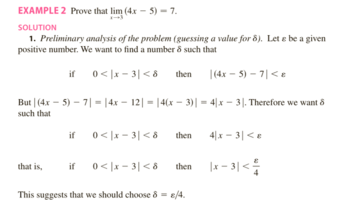If you want a more intuitive approach then see Jerome Keisler's
Elementary Calculus: An Infinitesimal Approach
The chapters or the whole book is
a free down-load at HERE.
Do you understand that [imath][-3,7]=\{x:|x-2|\le 5\}~?[/imath]
The midpoint of the interval [imath][-3,7][/imath] is [imath]2 [/imath] its radius is [imath]5[/imath]
Thus in the limit notation, [imath]\bf{\mathop {\lim }\limits_{x \to {x_0}} f\left( x \right) = L}[/imath]
means that if [imath]x\approx x_0[/imath] then [imath] f \left( x_0\right)\approx L[/imath].
OR for [imath]\bf x\approx x_0[/imath] then [imath]\bf f \left( x\right)\approx L[/imath]
What does it mean for one number to to be near another?
Well [imath]\{x\in (a-10^{-100},a+10^{-100})\}[/imath] is a set of
all numbers very very near to [imath]\bf a[/imath].
Thus if [imath]\epsilon>0[/imath] such that [imath] \exists \delta>0[/imath] and
if [imath]\{t\in (x_0-\delta,x_0+\delta\}[/imath]
then [imath]f(t)\in (L-\epsilon,L+\epsilon)[/imath]
i.e. if [imath]\bf t[/imath]
is near [imath]\bf x_0[/imath]
then [imath]\bf f(t)[/imath]
is near [imath]\bf L[/imath]
In my view
you in post #1
were correct if only you had stopped after: this suggests that [imath]\bf\large\delta=\dfrac{\epsilon}{4}[/imath]


